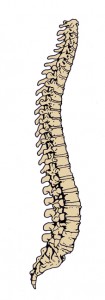Neck pain and lower back pain often go hand in hand but even if you have one without the other they are always related. The relationship of the lower back and the neck are such that the misalignment of one always affects the other.
The spine is made up of four curves; two that curve out, the sacral (pelvis area) and thoracic (upper back), and two that curve in, the cervical (the neck), and the lumbar (lower back). The lower back and the neck are designed to be mirror images of each other. They should have the exact same degree of curve and are meant to be aligned right on top of one another. If and when they don’t the ability of the spine to transfer weight successfully from top to bottom is compromised.
 Our ability to have good posture is largely determined by the position of the pelvis and the tone of the core. If my assessment that most people habitually tuck their pelvis under is correct, then these people are all flattening their lumbar curve to one degree or another.
Our ability to have good posture is largely determined by the position of the pelvis and the tone of the core. If my assessment that most people habitually tuck their pelvis under is correct, then these people are all flattening their lumbar curve to one degree or another.
Once the lumbar curve flattens the likelihood of neck pain and lower back pain goes up incrementally. The curve of the lower back supports the weight of the spine above it and the head on top of it. Once the lower curve starts to go the cervical spine and the head go with it.
You can probably feel this as you sit in your chair. Hopefully you are sitting up straight at your desk right now with your lumbar curve in its proper position but unfortunately, I would hazard that many of you are tucking your pelvis as you read. Either way—if you are sitting well or poorly, tuck more (round the lower back into the back of your chair) and feel what happens to your head.
The lumbar and cervical spine are intimately connected neck pain and lower back pain are hard to avoid if we don’t work to bring these curves into balance.
***
